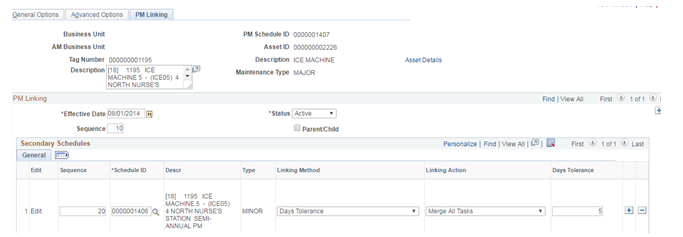 Preventive Maintenance Linking functionality allows for multiple preventive maintenance jobs for the same asset to be structured in such a way as to avoid multiple work orders and overlap of the same steps.
Preventive Maintenance Linking functionality allows for multiple preventive maintenance jobs for the same asset to be structured in such a way as to avoid multiple work orders and overlap of the same steps.
Let’s take an HVAC unit for example. A quarterly job may be to do a general overview of the equipment and to change the filter, while an annual job requires more thorough maintenance as well as a filter change. During the annual maintenance there is no need to change the filter as that step was included in the quarterly job.
Based on the Linking Actions determined in the set-up the Preventive Maintenance Linking, functionality can be structured so that only one work order will be generated with all the needed steps for the annual job. The primary and secondary schedules, (quarterly/annual), are determined by the maintenance types that are assigned to the schedule, as well as the schedule’s description. This synchronization reduces both equipment downtime and the possibility of performing unnecessary maintenance.
There are three types or Linking Actions for Preventive Maintenance Linking:
- Merge: The Preventive Maintenance Linking process merges the secondary schedule tasks to the primary schedule tasks for the same work order.

Notice that the one work order displays both the major and minor PM jobs and they are each identified as a separate task.

- Separate: The Preventive Maintenance process creates separate work orders for primary and secondary schedules with the same due date. Both work orders would be generated on the same date, the technician performing all tasks required for both jobs (major and minor) and identifying the results on the appropriate work order.
- Suppress: The Preventive Maintenance process lists only the primary schedule tasks in the work order. No work order will be created for the secondary schedule tasks. However, a PM record transaction will be created for the secondary schedule, which points to the work order created for the primary schedule.

In addition to Linking Actions, there are two options for Linking Methods.
- Days Tolerance: Selecting this method enables the Preventive Maintenance process to use the number of days entered to calculate when the system can link the primary and selected secondary preventive maintenance schedules based on the specified difference in the dates. This is generally used for date-driven preventive maintenance schedules. For example, if the quarterly is scheduled on the 1st of each month and the annual is scheduled on the 5th, you would set a day’s tolerance of 5 so that the system would look inclusively at the two scheduled start dates in order to determine if the link was valid or not.
- Linking by Cycle: Selecting this option enables the system to link a secondary schedule with a primary schedule based on a cyclical period determined by the selection of an interval type. This is generally used for meter-driven preventive maintenance schedules.
- Two important notes to keep in mind around Preventative Maintenance Linking are:
- Linking the PM jobs must occur before the first set of PMs are run.
- Each Maintenance Type must be unique in the linking grouping, i.e. major, minor, planned, etc. You can’t have a duplicate type such as two minor jobs within each group.
If you have any questions or would like to chat about this or any other PeopleSoft module please contact me at robin.cole@miproconsulting or larry.zagata@miproconsulting.com.

